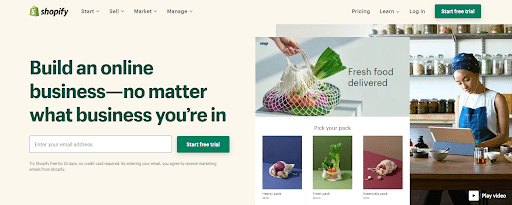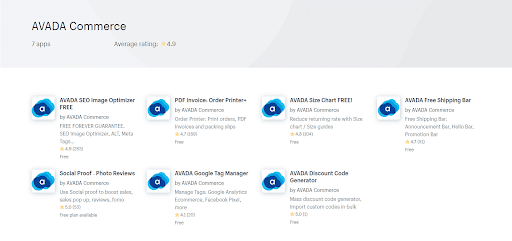eCommerce’s future is brighter than ever, especially with brick and mortar stores facing numerous challenges during the pandemic and social distancing rules. Online shopping used to be just for convenience; now, it is a necessity. That said, starting an eCommerce business and gaining a profit still requires hard work, as well as careful planning.
To help, I’ve created this article as a guide on how to build your first profitable eCommerce website in just five easy steps. It will cover all the most important tasks of creating a business, such as researching, launching, and gaining a chunk of revenue. With the right plan and approach, everything is possible. Let’s get started!
Step 1: Find an eCommerce business idea

The first step to build your first profitable eCommerce website is knowing your business’s position on the market. Don’t start off of a hunch. Growing any business is an investment, so you should treat it as such.
Your business idea should start from the resources that you have and whether or not you can build a store out of them. Your resources are your skillset, connection, capital capacity, and anything else related to starting an online business. Then, find a product that suits your resources and is what you want to sell directly to consumers.
Next, you need to understand the basic business models available:
- Dropshipping: It is a smart choice if you want to have a profit without stocking the product or investing heavily at the start.
- Retailer: With this, you stock goods and sell in small quantities, which is the most common model.
- Wholesaling: You invest more upfront and have a warehouse full of goods, then sell them in large quantities.
- Subscription: You curate a set of products to be delivered to your customers at regular intervals.
You have a product idea and a business model, but you still have one more thing to do before selling. You need to identify the brand persona and how it can cater to your customers. Who are you? What do you represent? Who are your target customers? A consistent brand image will take you for a long ride.
Step 2: Identify suppliers for your products
You will have many competitors selling the same products online, so you should look for the best quality and the best price for your products or the materials you use to create your product. Search around until you find a supplier you want to do business with for a long time – this includes your eCommerce platform. Think about how you’re gonna scale from the start.
There are three basic types of suppliers for your products:
- Manufacturer: The companies that actually produce goods with machines and workforce.
- Trading company: They work with manufacturers and export goods overseas to you or your customers. There is often a minimum order quantity.
- Wholesaler: Who sources goods in bulk and sells in large quantities.
Depending on the location of your suppliers, you will have to adjust your product price to make sure a profit is til present. You may have to shop around for a while before fingers with the suppliers with the best quality and price, but it is worth it for every stage of your business.
Step 3: Select a platform to sell

There are hundreds of eCommerce store builder platforms. Choosing the right e-commerce software is not easy. You need to carefully evaluate things like download speed, features, compatibility with different payment gateways, compatibility with your business structure, web developer skills, personal features, SEO friendly, and more.
You do not need a coding background to get started with your eCommerce store. Thanks to so many options out there, you may not need to touch the code.
- Shopify: Shopify is rapidly developing into an eCommerce giant with over a million active users and $46 billion worth of sales. It is one of the most robust website builders with an easy-to-use interface. There are three pricing plans suitable for every size of an online business. A Shopify referral software lets you make the most out of your ecommerce site.
- Magento: Magento is an advanced website platform that can scale well with even thousands of products. The customization is not for beginners, though, since you may need to hire a Magento developer to make changes, and it is costly when you grow bigger.
- Amazon, eBay, and Etsy: They are all online marketplaces with billions of dollars worth of products. You can expose your online store and products to many potential customers from around the world. But they also have fierce competition, transaction fees, and less customization.
- WooCommerce: Perfect for websites on WordPress, WooCommerce is a free extension to turn your existing website into an eCommerce site. It is more for intermediate to advanced online store owners with experience in building WordPress stores.
- BigCommerce: BigCommerce is an easy-to-use eCommerce platform to build and customize your online store. It also has many responsive templates to increase conversion. The pricing plans are quite similar to Shopify’s.
And still, there are more options unlisted. It is important that you choose the platform that suits your needs, resources, and scaling plans.
Step 4: Create an online business site
After you decide on your eCommerce platform, don’t hire an expert or an expensive development company yet. Just use a theme first, you can get a good template with less than $ 100 or more, depending on the theme you choose and what they offer. BigCommerce, Shopify, and WooCommerce all have many ready-to-use templates for you to try.
You Might Also Like:
If you don’t want to worry about setting up credit card payments, you can sell on a marketplace like Amazon or eBay. If you love the idea of expanding your own digital real estate, make sure your eCommerce platform is scalable and integrable with popular marketplaces to increase your visibility. And yes, if it’s too late to start an Amazon business, you can also try other marketplaces.
More than adding your products and content, you also need to set up email marketing and automation features. This is very important to have before you gain traffic to your site. Email marketing is essential to drive conversions with coupons, thank you emails, and upsell offers so you can turn visitors into consumers.
Your business site should provide an excellent user experience with helpful customer support to keep customers coming back, so keep that in mind when you design your online store.
Step 5: Build a profitable eCommerce website

Aside from using an eCommerce platform, you will need to determine your brand’s name, logo, and understand the basics of search engine optimization to properly structure your site and gain a good ranking on the search engines. From there, you can use many crucial elements to help you build a high-converting eCommerce website: captivating product descriptions, beautiful product photography, eCommerce color palette, and much more.
But that is not all. Since there is no guarantee that customers will come just because you have a good-looking website. You need to market your store to attract customers. Set a launch date and drum up some excitement; this can help you build an early community of potential customers, try using some kind of incentives.
From then, there are three basic factors that you will have to constantly monitor to build and grow a profitable eCommerce business:
- Sales strategies: You know your products and how it can help the customers, but you need the right approach to persuade the buyers. How would you introduce yourself? How would you explain your products? What is the special thing about your business that consumers can’t find anywhere else? It is more than just the price; it is the value that you have.
- Marketing strategies: How would you market your product or brand? Will you use social media, pay-per-click ads, viral content, influencers, or a combination of many tactics? How would you monitor the campaigns and where to get help? It is a broad area, but you can start with the email list as mentioned above and keep testing on which channels suit your business.
- Customer service strategies: Every touchpoint between your business and your customers is important. In general, don’t make your customers uncomfortable and strive to make an emotional connection whenever you can. You may encounter difficult customers from times to times, but try to keep a good brand image.
Try these apps to gain more profit!

For online store owners, there are many helpful apps to streamline the process and save time. Try these apps to make your life easier and gain more profit:
- Proofo – Social Proof App by Avada: Social proof plays a large role in customers’ decisions, so install this app to let visitors know about on-site activities like reviews, add-to-cart, purchase, and encourage them to take actions.
- SEO Suit by Avada: SEO directly affects your website ranking, but since you are not an expert, why not install an app and optimize your site effortlessly? The app is also free. However, you can also consider a service of MangoMatter to make your website SEO optimized. For Off-page Seo, you have to keep updated with your competitor backlink profile so you can use different SEO tools like Ahrefs, and you can also do manual research to know more about this.
- Free Shipping Bar by Avada: Free, simple, and effective, this app can help increase customers’ shopping cart size with many free shipping offers.
Final words
Did this guide help answer your questions on how to build your first profitable eCommerce website? If so, feel free to share. If not, head to the comments section and I will reply to your concern. Building an online store is fun and rewarding, so I always want you to have all the tools you need to succeed.
Thanks for reading, and best of luck on your eCommerce journey!
Read Also
- WordPress Security Guide
- 5 Ways to Deliver Excellent and Consistent Customer Service
- The Influence of Container Security on WordPress
- Do Online Companies Really Need To Invest In Apps?
- How to Choose the Right Type of SSL Certificate
- Elfie WordPress Theme Review
- How To Do Exponents In Java
- Templately Review
- How to Hire the Best Offshore Outsourcing Company
- 6 Essential Tips to Build a Successful Tech Start-up
- Shopify Vs WooCommerce
- How To Cancel A PayPal Payment
- 5 Popular B2B eCommerce Trends
- How CRM Can Help Accelerate Your Business Growth
- Wix Logo Maker Review
- How to Determine The ROI of your B2B eCommerce Project
- How To Build Email List From Scratch


